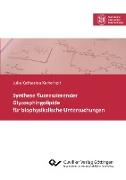Synthese fluoreszierender Glycosphingolipide für biophysikalische Untersuchungen
BücherAngebote / Angebote:
Glycolipide stellen einen wesentlichen Bestandteil der Zellmembran von Säugetieren dar. Insbesondere Glycosphingolipide spielen eine wichtige Rolle in einer Vielzahl (patho)physiologischer Prozesse und sind darüber hinaus entscheidend an der Organisation der Membran beteiligt. Als zentrales Thema dieser Arbeit wurde ein modularer Syntheseweg zur Herstellung von fluoreszierenden Derivaten des Glycosphingolipids Gb3 (Globotriaosylceramid) für biophysikalische Untersuchungen entwickelt. Dabei wurde ein BODIPY-Fluorophor über Polyethylenglycol-Linker verschiedener Länge an der Kohlenhydrat-Kopfgruppe angebracht. Es wurde angenommen, dass das natürliche Verhalten dieser Verbindungen in der Membran und ihre Funktion als Rezeptor für das bakterielle Shiga-Toxin durch die Modifikation in der ausgewählten Position nicht oder nur geringfügig verändert werden. Der unpolare Ceramidteil wurde variiert, indem an das Sphingosin-Grundgerüst verschiedene Fettsäuren angebracht wurden. Der Einfluss, den die Art der Fettsäure auf das Verhalten der Glycolipide in der Membran hat, kann mit den hergestellten Verbindungen untersucht werden. Zudem kann die Bindung an das Shiga-Toxin visualisiert werden.
Glycolipids represent an essential structural component of mammalian cell membranes. Especially glycosphingolipids play an important role in many (patho)physiological processes and are crucial for membrane organization. The main effort of this thesis was focused on developing a modular synthesis of fluorescent derivatives of the glycosphingolipid Gb3 (globotriaosylceramide) for biophysical investigations. The designed strategy was used to attach a BODIPY fluorophore to the carbohydrate head group via PEG linkers of different lengths. It was assumed that modifying the carbohydrate head group in the chosen position would not alter the phase behavior of the glycolipids in membranes to a large extent nor would it disturb their natural function as receptor for bacterial Shiga toxin. The unpolar ceramide part was varied by attaching different fatty acids to the sphingosine backbone. A detailed understanding of the influence the fatty acid has on the phase behavior in membranes can thus be gained with the help of the compounds presented herein. Further, Shiga toxin binding can be visualized.
Folgt in ca. 10 Arbeitstagen




